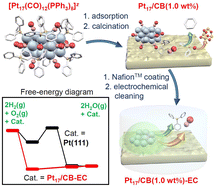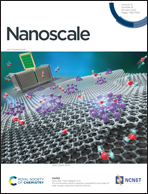Pt17 nanocluster electrocatalysts: preparation and origin of high oxygen reduction reaction activity†
Abstract
We recently found that [Pt17(CO)12(PPh3)8]z (Pt = platinum; CO = carbon monoxide; PPh3 = triphenylphosphine; z = 1+ or 2+) is a Pt nanocluster (Pt NC) that can be synthesized with atomic precision in air. The present study demonstrates that it is possible to prepare a Pt17-supported carbon black (CB) catalyst (Pt17/CB) with 2.1 times higher oxygen reduction reaction (ORR) activity than commercial Pt nanoparticles/CB by the adsorption of [Pt17(CO)12(PPh3)8]z onto CB and subsequent calcination of the catalyst. Density functional theory calculation strongly suggests that the high ORR activity of Pt17/CB originates from the surface Pt atoms that have an electronic structure appropriate for the progress of ORR. These results are expected to provide design guidelines for the fabrication of highly active ORR catalysts using Pt NCs with a diameter of about 1 nm and thereby enabling the use of reduced amounts of Pt in polymer electrolyte fuel cells.

- This article is part of the themed collection: Nanoscale Most Popular 2023 Articles


 Please wait while we load your content...
Please wait while we load your content...